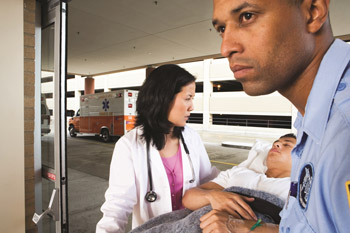Planned safe injection site aims to curb overdose deaths
Founders of a new nonprofit in Philadelphia are attempting to open the nation's first legal overdose prevention site.
Nearly 200 people in the United States die of drug overdoses every day, according to the CDC. In 2017, Pennsylvania had the third-highest rate of drug overdose deaths, 44.3 per 100,000, trailing only West Virginia and Ohio.
Thus, the American Public Health Association's annual meeting in Philadelphia in November 2019 was an appropriate place for experts to gather and discuss reducing harm from opioid use.
The number of drug overdose deaths in the city began rising around 2010 before jumping by nearly threefold in 2017, surpassing 1,200 deaths, said Thomas Farley, MD, MPH, health commissioner for Philadelphia. That's about 30% higher than the number of deaths the city saw from AIDS at its worst year of that crisis in 1994, he said. “This puts Philadelphia among the top cities in the country as far as drug overdose death rates.”
Overdoses are also sending more city residents to the hospital. The rate of ED visits for overdose by opioids, heroin, or unspecified substances per 1,000 visits more than doubled in a 10-year period, from 3.34 in September 2009 to 7.35 in September 2019, according to data from the Philadelphia Department of Public Health.

Founders of a new nonprofit, Safehouse, are attempting to open the nation's first legal overdose prevention site, also known as a safe injection or consumption facility. At the conference, they explained why they believe this strategy could save lives.
‘Fentanyl changed everything’
The overdose crisis in Philadelphia unfolded in three waves, said Dr. Farley.
First, in the early 2000s, there was the increase in pharmaceutical opioid use. Then, around 2011 to 2012, there was an increase in overdose deaths involving heroin, which is much cheaper on the street than opioid pills. Finally, starting around 2014 and 2015, there was a “huge surge” in deaths involving fentanyl, he said. “Fentanyl is found in nearly 90% of overdose deaths in which opioids are found, and nearly 80% of all overdose deaths.”
No ZIP code in the city has been spared by the overdose crisis, but there is a large hotspot in its Kensington neighborhood. Syringe exchange efforts have been strategically positioned there, allowing individuals who inject drugs to trade used syringes for new ones, said Jose Benitez, executive director of Prevention Point, a harm reduction program that offers syringe exchange and other services in the city.
In the last five years, the number of participants in Prevention Point's syringe exchange program grew from 4,000 to 15,000, he said. But even with a brick-and-mortar syringe exchange in Kensington and mobile sites throughout the city, overdose deaths keep happening. “Fentanyl changed everything. … It's changed all of the different systems, and it demands that we change as a community to address the issue that we have at hand,” Mr. Benitez said.
Working in Kensington every day, he said he sees a situation beyond compare. “We're now experiencing two to three overdoses a day, easily. When we have surges, sometimes that number could go up to between 15 to 20 a day. … I was a social worker when we were in the midst of the height of the AIDS epidemic, and [that was] nothing compared to what we see now.”
Additional consequences include a slight uptick in the number of new HIV cases and more people with skin-tissue damage, he said. “One of the factors is we're not putting out enough equipment, because what fentanyl did was also increase the number of times that people have to shoot up,” he said. “You've gone from two to three times a day to eight to 12 times a day.”
After Prevention Point provides its services, which also include free naloxone, staff members must send individuals someplace else to inject drugs, he said. People typically do this in an alley, between cars, on the corner, or even in the nonprofit's bathroom. Staff members are not aware that people have overdosed and need medical attention unless a bystander comes in to inform them.
“What's missing at Prevention Point is this extra step of medically supervising someone who's going to inject drugs,” said Mr. Benitez.
Taking action
In response to the overdose crisis, Philadelphia Mayor Jim Kenney formed an Opioid Task Force in 2017. It recommended four areas of action: prevention and education, access to treatment, overdose prevention, and involvement of the criminal justice system. As part of the plan to prevent overdoses, the task force committed to explore opening one or more safe consumption facilities.
Such facilities, also called comprehensive user engagement sites, offer referral to treatment and social services, wound care, medically supervised drug consumption, and access to sterile injection equipment and naloxone in a walk-in setting, according to a report by the task force. They have been in operation since 1988, first in Europe and then Australia and Canada, and have been associated with improvements in public health outcomes, the report said.
The opening of a safe injection facility in Vancouver, for example, was associated with a 35% reduction in the fatal overdose rate in the immediate area, while the fatal overdose rate decreased by only 9% in the rest of the city, according to a study published in 2011 by The Lancet. Other studies have found that in addition to overdose deaths, the facilities have been associated with reduced disease transmission, injection-related infections, and other adverse outcomes.
To explore the potential annual impact of placing one overdose prevention site in Kensington, the most heavily affected part of Philadelphia, the health department hired a research expert to review the literature and make some estimates, said Dr. Farley, who co-chaired the Opioid Task Force. “This is what she came up with: one to 18 cases of HIV, 15 to 213 cases of hepatitis C, and, most important, 24 to 76 overdoses prevented.”
The numbers were a bit of a reality check, he said, since they represented a small fraction of the 1,200 overdose deaths per year in the city. “On the other hand, if that's averaging 50 lives per year, that's an awful lot of people whose parents would not be losing children,” Dr. Farley said. “I spend too much of my time these days talking to parents who have lost children.”
In 2018, city administrators announced that they would support and encourage, but not fund, overdose prevention sites. They turned to Prevention Point to start the process.
A controversial medical model
Program leaders soon encountered a major obstacle in federal law. “There's a section of the federal Controlled Substances Act, which makes it, according to the Department of Justice … illegal to maintain a drug-involved premises for the purpose of using drugs,” said Ronda B. Goldfein, JD, an attorney and executive director of the AIDS Law Project of Pennsylvania.
Anticipating legal challenges, Mr. Benitez and Ms. Goldfein created a new nonprofit, Safehouse, to operate a proposed site. They also recruited criminal defense lawyers, insurance lawyers, and constitutional law scholars and enlisted a champion: former Philadelphia mayor and Pennsylvania governor Ed Rendell, who signed the executive order allowing Prevention Point to start operating when he was mayor in 1992 and now sits on Safehouse's board.
To distinguish Safehouse from the crack houses and rave parties the Controlled Substances Act statute was written to target, officials proposed a medically supervised model where no illegal drugs are provided on the premises, said Ms. Goldfein, vice president and secretary of Safehouse. In other words, clients would bring their own drugs. Medical staff members, including nurses, would be present at the site to administer naloxone in case a client experiences an overdose, to help direct clients to drug treatment, and to address other medical problems, Dr. Farley said.
Under the model, people who use drugs would arrive, register, and receive a basic assessment of physical and behavioral health to assure no immediate care is needed. Safehouse would offer a range of services: a medically supervised consumption room, a medically supervised observation room, medical services, and wraparound services.
The consumption room would provide sterile equipment, fentanyl test strips (although they will most likely test positive), overdose reversal and emergency care, and safe disposal of equipment. After using, clients would move to an observation room, where nurses and other trained staff would provide overdose reversal and emergency care if needed, certified peer specialists would provide guidance if desired, and nurses and other trained staff would offer additional services, such as on-site wound care; medication for opioid addiction; HIV and hepatitis C counseling, testing, and treatment; and referrals to primary care.
“Most importantly, we'll have trained staff standing by so that if the participant begins to show the signs of overdose, we can reverse it, and we have a detailed medical protocol about all the steps we will take. This will include rescue breathing and naloxone,” said Ms. Goldfein. “There's a plan in place, [and] also that plan can be executed in seconds.”
Finally, staff would provide community-based wraparound services, including referrals to social services, legal services, and housing opportunities. “Part of what we want to tell people is that if you want to change where you are, there's light at the end of that tunnel, and we can help you with those things,” Ms. Goldfein said.
What's next?
Not everyone has been thrilled with the idea, including the U.S. government. As Safehouse was proceeding with its plans, the U.S. Department of Justice announced that it would prosecute anyone opening an overdose prevention site.
In an August 2018 op-ed in the New York Times, Rod J. Rosenstein, who was serving as U.S. deputy attorney general at the time, issued a warning about the potential Philadelphia site, noting that it remains illegal under federal law and that staff and potentially clients would be subject to civil and criminal enforcement. “We said, ‘This just can't be true. It can't be true that the law won't allow us to save lives,’” Ms. Goldfein said.
In February 2019, the Department of Justice and the U.S. attorney for the Eastern District of Pennsylvania jointly filed a civil lawsuit against Safehouse, saying its site would violate the Controlled Substances Act statute.
From a legal standpoint, Safehouse's position was simple: The statute refers to the purpose of the facility. “Safehouse and overdose prevention sites are not opened for the purpose of unlawful drug use; they're open for the purpose of providing critical lifesaving care to people who use unlawful drugs,” said Ilana H. Eisenstein, a former federal prosecutor and outside counsel for Safehouse.
The nonprofit also had a medical argument. While Good Samaritans in streets and subways may try to be first responders, “This is an opportunity for the people who are medical professionals to provide that care immediately,” Ms. Eisenstein said, “and it's our position that that does not violate that federal law.”
Most recently, a federal judge sided with Safehouse. In October 2019, a U.S. District Court judge ruled that Safehouse's ultimate goal is to provide medical care, not to promote or facilitate unlawful drug use. Therefore, the site does not violate the statute and may move forward, the court ruled.
As of November 2019, a final order has not been entered in the case, but Safehouse plans to open once it has authority to do so, Ms. Eisenstein said. Then, Safehouse's opponents are expected to appeal the decision, with the case possibly eventually going all the way to the U.S. Supreme Court, she said.
“This is the first case of its kind,” said Ms. Eisenstein. “… We look forward to continuing to defend this from a legal perspective as the folks here are working to bring this into operation.”





